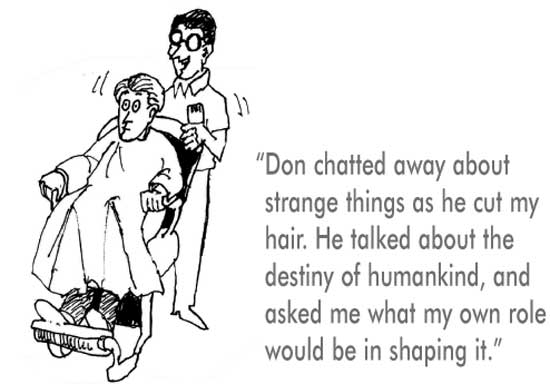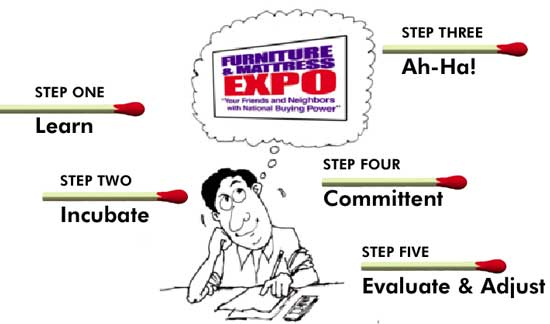
I had no idea that my entire life would change when I walked into a little barber shop in Mount Rainer, Maryland and met Don the Barber. When I strolled in I was an 18-year old high school graduate with a foggy, undefined future. I was working in a lumber yard. When I left Don’s shop I carried the secret of destiny with me.
I didn’t know it, but the book I had in hand would teach me the one thing most people fail to do when they are in a desperate situation: It would teach me that it was possible to think my way out of any situation, no matter how dire. Not that I would learn this lesson quickly. To learn to think takes a lifetime of effort. And just when you imagine you know how to think, you realize that you have barely scratched the surface. What this book convinced me is that it is possible to learn to think creatively. And simply believing in the possibilities of a new way to live radically altered my future.
In this article I will explain what I learned, and tell you how to apply creative techniques to sell more home furnishings. It will be possible to do this because I have seen these creative principles applied by some of the great furniture entrepreneurs. My first furniture job was working for Charles Curtis of Curtis Bros. Furniture in Washington, D.C. At the time, Curtis Bros. was the largest furniture store under one roof in America. Charles achieved the first single location million-dollar month in furniture history. After that I worked for Clyde Bedell, the great advertising genius. There followed tours of duty for Leon Levitz, and then John F. Lawhon. Each of these men had a vital piece of the puzzle. Each was creative in a unique, pragmatic way. And each of them made a lot of money. Yet times have changed. Now additional creative techniques are necessary to achieve success in marketing home furnishings. I will explain. But first, let’s return to the gift of Don the Barber.
I AM LENT A WEIRD BOOK
Don chatted away about strange things as he cut my hair. He talked about the destiny of humankind, and asked me what my own role would be in shaping it. I was completely puzzled by the subject. At the time I was hoping to get a job with the telephone company so I could make a reasonable wage and have some job security. That was the extent of my aspirations. But he brushed this aside and urged me to dare to a dream of “a triumphant human life.” This was confusing to me, but it was kind of fun to talk with Don.

And when I paid him for the haircut, he handed me a book. Don expressed his desire that I would read it. When I looked at the cover, I was really baffled: “Raja Yoga, or Mental Development.” I looked into his eyes hopefully.
“Don, you don’t believe all this stuff do you?”
Don smiled and replied: “Oh, I’m not asking you to believe anything. A book is like a cafeteria. If you see something you like, take it. If what you see does not appeal to you, pass it by for now. You may change your mind and go back for it later.”
Later, in my room, I read by an open window.
“We are perhaps unaccustomed to the idea of mastery over our own inner thoughts and feelings… It should be as easy to expel an obnoxious thought from your mind as it is to shake a stone out of your shoe; and until you can do that it is useless to talk about ascendency over Nature, and the rest of it ...
“Yet the weary and careworn faces that we meet by the thousands, even among the affluent classes of civilization, testify too clearly how seldom this mastery is obtained.”
I read and read. When I looked up, daylight was fading. I looked around at the poverty of my surroundings. But now I believed something I never even considered before. There is another way to live. My education had begun.
WHAT DOES THIS HAVE TO DO WITH furniture sales?
Actually, creative Thinking (with a capital T) can save the struggling independent furniture entrepreneur. I receive many calls from desperate store owners claiming that big box stores are ruining their businesses. I first ask whether they have family-friendly store hours. Almost always they disclose store hours that make it difficult for a couple to shop the store together. So (in most cases), by having no days with evening hours and making Saturday the only day to shop the store’s selection as a couple, these entrepreneurs train prospective customers to choose one of the big boxes instead.
All big boxes have convenient store hours. Hours are not a cure-all, but they are becoming increasingly important. Next, I check the store’s website. Websites are the most grievously ignored opportunity for the independent. Even large independents rarely look at their websites on a regular basis. Are they posting their current ads? Are their websites up to par with the latest goings on? Even grandpa uses the internet to get shopping information these days.
If struggling stores want to attract more traffic, convenient hours and vibrant websites are two simple tactics that cost very little but could set into motion a game changing attitude. Change is inevitable, and never has it been so virulent as in recent years in the furniture industry. The good news is that smart independent retailers who are willing to adapt to change can flourish. There are so many tactical things an independent can do that big boxes cannot. But before you can employ killer tactics with maximum effectiveness you must first have a creative, strategic game plan. The New York Giants would never enter into a football game against the New England Patriots with a bunch of good plays but no strategic game plan.
What I learned from “Raja Yoga” was the need to think strategically. Charles Curtis and each of the other great furniture men I worked for had this capacity to think creatively and strategically. They sold furniture and they made money. They were not perfect, in fact they made mistakes. I watched a couple of them rise to the top of the industry and then slowly fade away. What was the missing ingredient each seemed to lack? It was something they had in abundance at one time, but they somehow lost along the way. Empathy. Not just empathy for their customers, empathy for their associates and vendors.
Consider the independent who set his store hours in place over twenty years ago. That was before so many families were headed by two working adults. It was before people were so busy and had so little free time. It was before the big boxes offered evening and Sunday hours. Modern shoppers do not want to arrange their schedules to shop at the convenience of the furniture store owner. Wise entrepreneurs consider it their strategic mission to strive to improve the lives of their customers. This requires a special degree of empathy for the demanding schedules of today’s families.
But all of this aside, I promised you some pragmatic creative techniques that you can use to sell more home furnishings. Here are three of the best I know.
THE THREE KEY FURNITURE RETAILING CREATIVE STRATEGIES
1. Time Blocking: How to set aside nine forty-hour weeks dedicated to strategic planning. For the average under-performing entrepreneur, learning ends after formal education stops. This will not do if you want to achieve retailing excellence. An investment of an hour a day toward new strategies and skills will give you an important competitive edge.
Why? Because the odds are good that not a single one of your competitors will make this commitment. One hour each day equals over nine forty-hour weeks a year. In five years, you will have accumulated forty-five work-weeks of research and study. What kind of progress do you imagine you could make if you invested forty-five work-weeks of research and study over the five-year period? Because almost no one does this, you can look forward to some degree of proficiency in a year. In three years, you should be outstanding in your field. In five years, you will have spent over forty-five weeks of effort toward your goals. With any luck at all, you will be world-class. But if an hour a day is out of the question, even one hour a week of undistracted time to think will yield big improvements and greater success.
2.Leveraging with Synergy: How to make one plus one equal four. Seem impossible? The secret of leveraging your resources is born of the understanding of synergy. Many years ago, a man named Buckminster Fuller said that when you combine certain ingredients the result cannot be predicted. For example, when you combine two volatile gases, oxygen and hydrogen, you get water, a liquid that puts fires out!

If I gave you six matches and challenged you to arrange them to make two triangles, you would have no difficulty. But if I challenged you to arrange them to make four triangles, you would certainly have much more difficulty. To most people the challenge would appear impossible. “There just aren’t enough matches,” they might complain.

However, if we could change a person’s attitude toward the problem, and get him or her to consider the possibilities rather than just the obstacles and limitations, a solution could emerge. What changed?
Attitude was the only change. First, the mental attitude. When you expand your own vision, when you approach a problem with the belief that a solution is possible, new possibilities become obvious.
Attitude also has another meaning. It also means the position of an object in relation to other things – its relationship to other things. To solve the problem, we had to change the relationship of the matches to one another. I believe you can see the correlation between this puzzle and making the most of your resources.
3. The “Secret” Formula for Unlocking Your Creativity. The formula I am about to show you was featured in the “Raja Yoga” book that was originally published in 1906. More recently a big time advertising expert claimed it for his own. He wrote that the reason he was willing to reveal this “secret” was because he knew no one would use it, it is so unique. But he also claimed the formula was the key to his success.
Like most secrets, this one has been lying around in plain sight for a long, long time. However, I use it constantly. I have no idea how the formula works, I only know it does. It has five simple steps.
STEP ONE is to cram your mind with all the factual information about the issue you can.
STEP TWO is to consciously “drop” everything into your super-conscious mind. Command the mind to work out a solution. This incubation period is crucial. Resist the temptation to “open the oven door” to see how things are going. Just forget the issue and do other things. Before you know it the buzzer will go off.
STEP THREE is the “Ah Ha” moment. The solution emerges.
STEP FOUR is the action step. No decision is complete until it is acted out.
STEP FIVE is to evaluate the results. Adjust, and recycle.

I have only scratched the surface of the creative tactics that you can employ to be more productive and successful. Remember that you have under-used or unused resources that the big box corporate competition cannot employ. They are locked into item-price presentations that all look just about the same. Don’t try to copy them, don’t compete in their bloody shark tank. Rather, create a “Blue Ocean” domain of your own. People are silently begging for an empathetic furniture retailer in your market who can be trusted. That’s you. You have virtually unlimited possibilities to establish yourself as the preeminent retailer in your market.
Furniture World is the oldest, continuously published trade publication in the United States. It is published for the benefit of furniture retail executives. Print circulation of 20,000 is directed primarily to furniture retailers in the US and Canada. In 1970, the magazine established and endowed the Bernice Bienenstock Furniture Library (www.furniturelibrary.com) in High Point, NC, now a public foundation containing more than 5,000 books on furniture and design dating from 1620. For more information contact editor@furninfo.com.